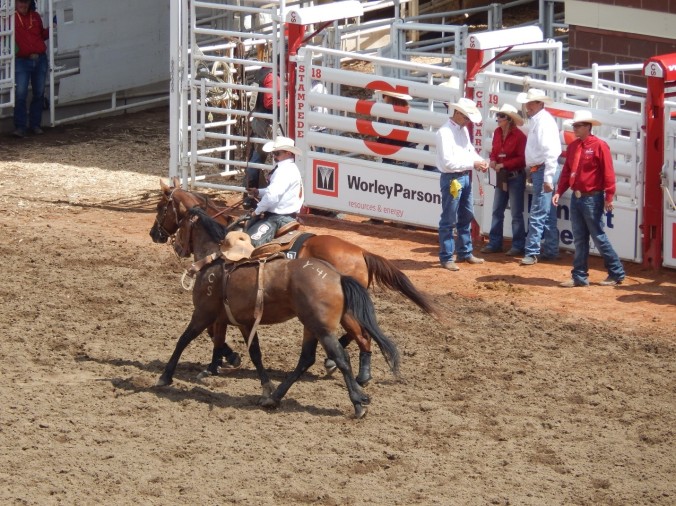
At the end of this year’s rodeo season, and as the National Finals Rodeo (NFR) approaches, pondering how we came to have a National Finals, or even how some of the biggest professional rodeos became prestigious led me to reflect on my trip to Calgary this summer. When you ask young cowboys and cowgirls just starting in junior rodeo, where they want to ride someday, they will most often say: the Calgary Stampede, the Pendleton Round-Up, and the Big Daddy–Cheyenne Frontier Days. Why isn’t the NFR on their list? It is after all considered by many to be the Super Bowl equivalent in rodeo. Even a kid knows that if he or she is good enough to ride in the big three, they are already well on their way to the NFR.
I haven’t attended a National Finals rodeo yet, but I attended the Calgary Stampede for the first time this summer, and it was one of the best rodeos I have ever been to. Now, I’ve been going to rodeos all my life. My dad was a bull rider when I was little and my mom told stories of me staying up late to watch the bulls, and the re-rides which they used to do right after. About 1:00 a.m. when we got into the car to go home, she said I would finally fall asleep. So I have loved rodeo from the beginning.

When I walked up to the gates to go into the Stampede I got goose bumps. It is hard to explain the emotions that well up; knowing the history of the Stampede and with a love of the ranch life that helped form organized rodeo. Yet, excitement replaced nostalgia because I knew that I was going to witness the best of the best at the Stampede. Since 1912 the Stampede has centered on community with the contestants, the staff, and the entire city. As a historian the question then becomes, how did the Calgary Stampede become so prestigious? What makes it stand apart from the thousands of rodeos held every year? In this case it really starts at the beginning. What was created to be a one-time farewell commemoration and celebration of a disappearing ranching life in southern Alberta, ironically became the event that showcases it and now contributes approximately 345 million dollars throughout the province.[1] Funded by four area cattle barons, Guy Weadicks’ vision for the rodeo established a unique event that was “not conceived, nor was it ever designed by its original sponsors, to be just an ordinary cowboy show.” Weadick recreated the frontier in a show “devoid of circus tinsel and far fetched fiction” to showcase the people and livestock important to the region. The Stampede has stayed true to Weadick’s dream by continuing to highlight rural agriculture in the region through the exhibition of agricultural products and good produced in the area and with the invitational rodeo and chuck wagon races that are now Stampede traditions.[2]

Overwhelming public support for this annual event is evident from the moment you get off the airplane and the customs agent says, “Welcome to the Stampede,” and this enthusiasm is reinforced in the many hats and boots seen all across the city. People assume everyone is “Stampeding” and in fact wish you a wonderful time even before they confirm that you are attending. The entire city is both accommodating and helpful as they co-host this event with the many workers and committees behind the scenes who make sure security is on duty, the vendors are set-up and the livestock are cared for. There’s a lot to the Stampede besides just the rodeo, and the entire event is at the heart of this city.

This 1912 program is archived at the Glenbow Museum in Calgary, Alberta. Photograph taken by the author.
So, what makes the rodeo exceptional? It is in the roots of rodeo itself and in the hearts of the stock contractors, chute bosses, the arena hands, and even the tractor men (or women, I couldn’t see into the cab).

It is the select invitations to those athletes who stand out in the profession, and they are not always the athletes one expects to see annually at the NFR. Stampede contestants are outstanding competitors like Mary Burger, a 67-year-old grandmother from Paul’s Valley, Oklahoma who won the championship in barrel racing this year.

Another thing that sets the Stampede apart, is that competitors ride the best livestock in the business, and just like Weadick’s original vision, it is just rodeo, no gimmicks. This event showcases the best rodeo contestants and finest bucking stock in the world.

The tradition of educating the public continues today. The Stampede puts great effort in teaching the many first time visitors from all over the world who attend importance of the agricultural community and lifestyle. Explaining our heritage to future generations is key to sustaining it, be it rodeo, ranching, farming, or culture.

The venue is enormous: the midway, First Nations Village, the Exposition barns, the shows, the music, the celebration — all of it making up the Stampede. But, for me the best part of the rodeo is that the cowboys, cowgirls and livestock are the center stage. While it is impressive that some cowboys and cowgirls zip line into the arena during the opening ceremony, the exceptional talents of these athletes shine in the competition.
If you have not attended, it is a must for anyone with a heart for rodeo, or an appreciation for working animals, or just wanting to learn more about the western way of life. It is the exception, providing an incredible experience for those who attend.

[1] http://corporate.calgarystampede.com/about
[2] Guy Weadick, “How I Started the Calgary Stampede” from Guy Weadick manuscript, “Alberta Cow Country” Glenbow Archives, M1287 reprinted in Alberta History, Vol. 60 (Summer 2012), 2-3.